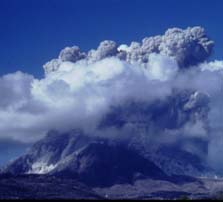
The deep plumbing of the Montserrat volcano resembles the digestive tract of a ruminant, writes Sarah Day
Geoscientist Online 9 October 2008
Cyclical eruptions of the Soufriere Hills volcano on Montserrat are caused by a ‘valve’ between a shallow magma chamber and a deeper chamber - rather like the sphincter between the rumen of a cow (which digests the food) and the animal's stomach, into which it periodically regurgitates.
The international team of researchers led by Professor Derek Elsworth of Penn State University, measured the inflation and deflation of the ground to gather information about how magma is transferred deep within the edifice and crust below. The data - published in today's issue of the journal Science, suggest that despite the cyclic eruption pattern, magma is in relatively constant supply at depth.
"Continuous records of surface deformation are available for only a few volcanoes", says Elsworth. ‘The Soufriere Hills volcano has been erupting since 1995 and provides a peek into the processes occurring deep beneath this stratovolcano.’
The volcano exhibits cycles of eruption and quiescence. The current cycle began in November 1995, when a dome of volcanic rock arose at the volcano's summit. There was a pause in above-ground activity from March 1998 until November 1999, during which the dome collapsed from its own weight and inactivity. A second episode continued until another pause began in July 2003, and the third began in October 2005, ending in March 2007. In August 2008, magma was extruded from the western flank of the dome, suggesting that another episode of eruptions had begun.
The cyclic eruptions appear to suggest that magma is produced periodically beneath the volcano; but the data suggest otherwise. During pauses in eruptions, the researchers believe, magma inflates a deeper chamber from which it is eventually released into an upper chamber - forcing renewed eruption. They believe that a ‘valve’ between the two chambers exists, allowing the lower reservoir to refill while the upper is open and unaffected. The cause of the magma release into the chamber is not known, but could be attributed to heat build-up or increased gas pressure.
The research suggests that it is the deeper chamber that is crucial in determining the timing of eruptions, rather than the shallow chamber as was previously thought. It also indicates that only the lower magma reservoir is depleted by eruptions, refilling (during pauses in eruptions) at only half the rate that it is emptied. The eruption periods last longer than the pauses in between, so the deep chamber is unable to make up the pre-eruption volume entirely, and contains less and less magma over time.